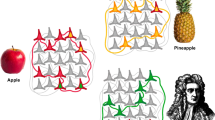Abstract
The essence of intelligence is to use certain abilities to obtain knowledge, to use that knowledge, and to operate with that knowledge. New knowledge learned by a human is often related to old existing knowledge, and sometimes we could have more conceptual knowledge based on old knowledge. So, the knowledge in the brain exists in a related structural form, and this structure is dynamic, and therefore is evolvable. Based on the understanding of the real process of learning by a human being, we discuss how to make a model to describe the dynamic structure of knowledge. This model is also a principle of artificial brain design. Most of the knowledge a child learns is from natural language and perception information, and we define this as semantic knowledge. The model to describe the process and structure of knowledge growing in a network form is called a K-net. It is a dynamic network with two main dynamics: one is new knowledge added, and the other is aggregating knowledge existing in the network with some probability. Under these very natural conditions, we found that the network is originally a simple random net, and then some characteristics of a complex network gradually appear when more new knowledge is added and aggregated. A more interesting phenomenon is the appearance of a random hierarchical structure. Does this mean emergence?
Similar content being viewed by others
References
Motter AE, de Moura APS, Lai Y-C, et al. (2002) Topology of the conceptual network of language. Phy Rev E 65:065102(1–4)
Sigman M, Cecchi GA (2002) Global organization of the wordnet lexicon. Proc Natl Acad Sci 99:1742–1747
Murre JMJ, Sturdy DPF (1995) The connectivity of the brain: multilevel quantitative analysis. Biol Cybernet 73:529–545
Dorogovtsev SN, Mendes JFF (2001) Language as an evolving word web. Proc R Soc London B 268(1485):2603–2606
Steyvers M, Tenenbaum JB (2005) The large-scale structure of semantic networks: statistical analyses and a model of semantic growth. Cognitive Sci 29:41–78
Watts DJ, Strogatz SH (1998) Collective dynamics of small-world networks. Nature 393:440–442
Érdi P, Szentagothai J (1985) Neural connectivities: between determinism and randomness. In: Aubin JP, Saari D, Sigmund K (eds) Dynamics of macrosystems. Springer, pp 21–29
Eguíluz VM, Chialvo DR, Cecchi G, et al. (2005) Scale-free brain functional networks. Phys Rev Lett 94:018102
Kim BJ (2004) Geographical coarsegraining of complex networks. Phys Rev Lett 93:168701
Chialvo DR (2004) Critical brain networks. Physica A 340: 756–765
Sporns O (2002) Network analysis, complexity, and brain function. Complexity 8:56–60
Alava MJ, Dorogovtsev SN (2005) Complex networks created by aggregatoin. Phys Rev E 71:036107(1–11)
Ravasz E, Barabási A-L (2003) Hierarchical organization in complex networks. Phys Rev E 67:026112
Author information
Authors and Affiliations
Corresponding author
About this article
Cite this article
Zhang, Y., Sugisaka, M. & Tang, L. K(Knowledge)-net: building up and its dynamics. Artif Life Robotics 12, 1–5 (2008). https://doi.org/10.1007/s10015-007-0435-y
Received:
Accepted:
Published:
Issue Date:
DOI: https://doi.org/10.1007/s10015-007-0435-y




